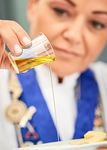Sensory Analysis Results, Brussels 2020
←
→
Page content transcription
If your browser does not render page correctly, please read the page content below
2
Sensory Analysis Results
Total Score
90.1%
Award
Sensory Evaluation
Total Score 90%
First Impression 93%
Vision 90%
Olfaction 83%
Taste 87%
Final sensations 88%
International Taste Institute
105A rue Colonel Bourg 1140 Brussels | www.taste-institute.com3
The jury
The world most professional jury of taste-experts
Products are tested by a large panel of professional taste-experts, members of the world’s
most prestigious Chef & Sommelier associations.
Over 200 jury members are carefully selected based on their experience in tasting. Their
talents are recognized in Chef and Sommelier competitions or by renowned institutions such
as Le guide Michelin or Gault & Millau.
Our jury members include many head-Sommeliers & Chefs from Michelin starred
restaurants like El Bulli(Spain) or Le Jules Vernes (France), best Chefs or Sommeliers from
various European countries, like Italy, Spain, Portugal, Belgium, Netherlands, Hungary etc,...
Chefs cooking for personalities like the French president or the Queen of England.
Judges come from over 20 countries. They are all external and independent.
Our partner Chef & Sommelier Associations
International Taste Institute
105A rue Colonel Bourg 1140 Brussels | www.taste-institute.com4
Tasting Methodology
Blind Sensory Analyses
Products are blind-tested, meaning that the tasters are not aware of
brand name, product name nor origin of the product. They only receive a
short description of the product category.
Each product is evaluated for its organoleptic quality following a
systematic approach based on the 5 International Hedonic Sensory
Analysis criteria (AFNOR XP V09A standards): First Impression, vision,
olfaction, taste, texture (food) or final sensation (drinks).
Each jury member evaluates and scores the product on his/her own, in
silence and without communication with other jury members.
Product Preparation & Presentation
All products are presented in standardized transparent or white
chinaware. This methodology ensures that any bias or preconceived
opinion about a food and beverage producer is avoided.
The products are prepared and served according to a precise protocol
strictly respecting the producer’s preparation and serving instructions.
The Taste Institute reserves the right to test the physical and chemical
components of the samples with accredited laboratories to ensure that
the products tested match the quality of products available to consumer.
Tasting Philosophy and scoring method
It is not a competition: each product is scored on its intrinsic
organoleptic quality.
The products are evaluated and scored according to what is expected
from a consumer product from its category.
Jury members are not asked whether they personally like the product or
not, but how good its organoleptic qualities are for a consumer product in
its category.
To some extent, taste is subjective and there certainly is a cultural factor
in taste; however, 15 years of taste evaluation experience with some of the best taste experts in the
world has demonstrated that in most cases there is a very strong consistency in the evaluations.
To reflect the overall hedonic quality, the Total score is a weighted average of the 5 International
Sensory Analysis criteria.
International Taste Institute
105A rue Colonel Bourg 1140 Brussels | www.taste-institute.com5
Sensory Criteria Definitions
First impression
The First impression refers to a first spontaneous overall gustative impression, before starting
the systematic analytical evaluation of the product.
The Jury is asked to give an overall spontaneous score about the gustatory pleasure
experienced when tasting the product.
Vision
It characterizes the visual quality of food & drinks; are evaluated dimensions such as:
colour, shape, size, transparency, dullness, glossiness, presence of residues, ...
The visual aspect should be pleasing and consistent with the aspect normally
associated to the category.
Olfaction
Olfaction characterizes the aromas perceived by the nose. A pleasant aroma makes
food appetising.
The sense of smell is useful in detecting freshness, rancidity or defects in food &
drinks.
It is a factor that plays an essential role in the flavour perception.
Taste
Taste characterizes the flavours perceived in the mouth and on the tongue.
There are five main types of taste sensations: Sweet, Salty, Sour, Bitter and Umami.
The taste is strongly connected to and influenced by aromas perceived by the nose.
Texture (Food products)
Texture is perceived by a combination of different senses i.e. mouthfeel, sight, and
hearing.
Texture is a key hedonic factor for many food products. For example, it can include
characteristics such as tenderness, crispiness, consistency, viscosity, chewiness and
size & shape of particles.
Final sensation (Drinks)
Final sensation refers to the sensations still present after the drink has been
swallowed.
International Taste Institute
105A rue Colonel Bourg 1140 Brussels | www.taste-institute.comYou can also read



























































